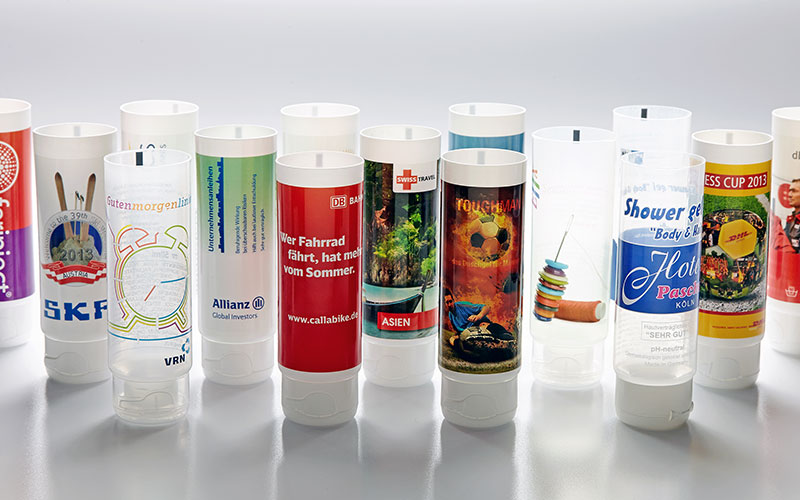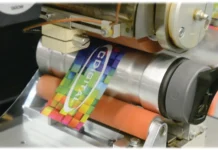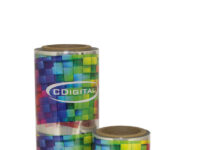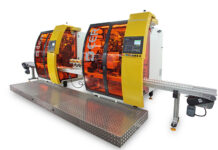Article provided courtesy of Digital Decorations, LLC
For the printing of shaped products, there are several ways to get it done from conventional printing technologies like screen or pad printing, to more modern ways, such as direct inkjet printing. But there is one technology that is not as common but should be known for its benefits – digital heat transfer decoration.
Heat transfer decorating in general is a two-step process, which separates the actual printing from the decorating. Although the heat transfer process itself is an established technology, only the screen or offset printed heat transfer decals are well known. The downside to these conventionally printed transfers is that they are only available in high quantities of several hundred thousand, and most of them are produced in Asia. To overcome these issues, digital heat transfer technology brings a more local solution for small to medium quantities and personalization to the world market. Furthermore, these can be printed with a higher print resolution, as well as eco-friendly technologies.
Digital heat transfer printing
It all begins with the actual printing. Here the client sends their artwork to a digital heat transfer printing company, where – in the best case – a prepress department checks and optimizes the files for their printing press. Using up-to-date equipment, a print quality of up to 1,200 dpi is possible. Therefore, the prints can be designed with nice gradients, fine textures and even texts as small as one pt., which can still be read. After going through prepress, the artwork files are printed onto a carrier material, which allows them to be released in the later transfer process. In most cases, another step in the printing workflow adds an adhesive to those transfers. These adhesives will increase the later adhesion to the material to which they will be applied. These materials include all kinds of plastics from untreated PP to ABS or SAN, as well as other non-plastic materials such as glass, wood or metals.
Depending on the technologies used by the printing company, it is possible to produce heat transfer decals that are not only safe to use but also eco-friendly. This means that they don’t contain any volatile organic compounds or UV curing monomers. Finally, the printed transfers will be cut into compact rolls that can be shipped to the client for application.
The application process
Once the customer’s transfers have arrived, they will be inserted into a heat transfer machine. These range from cheap and easy hand-fed machines to automated and safe high-quality equipment with a range of additional functionalities. Assuming the client has chosen a high-quality machine, an optical image registration system will position the transfer on top of the product. Once it is positioned, a hot rubber-coated plate or roller will press the print against the product. Due to the heat and pressure, the decal is activated and adheres to the product’s surface. After cooling down a little, the carrier material will be automatically peeled off, resulting in a decorated product. Although it sounds like a long procedure, the whole decoration process should take less than two seconds.
Now with the image applied, the process is complete. Unlike other printing technologies, no further drying or curing is needed, which allows for even faster turnaround times. Likewise, common problems like ink migration, solvent odors and the like are eliminated when decorating with heat transfer decals.
Heat transfer vs. other printing technologies
Just like any other printing technology, the digital heat transfer technology has applications where it really shines and others where it might not be the first choice. When comparing this technology with other printing technologies, it might be worth it to compare these before making a call on which way to go.
First, look at how digital heat transfers compare to screen or pad printing, as there are some cases where the conventional technologies should still be considered. One scenario that can favor these traditional technologies is print runs beyond 100,000 prints of the same artwork. In this case, the high volume will most probably make up for the high makeready cost. Furthermore, the benefits from the flexibility and low makeready costs of a digital printing technology are eliminated, as this is the advantage that brings down costs for lower volumes.
Another scenario can be a single- or two-color print job that does not need a photorealistic 1,200 dpi print resolution. Here the low makeready costs for setting up a one- or two-color machine, compared to a multicolor system, will have the same effect. However, chances are that printers won’t be able to set up a two-color screen-printing machine to do a 200-print run at the costs of a digital heat transfer. In other words, with high print volumes, those traditional technologies can be more favorable.
Another comparison is with a more modern printing alternative that should be considered, too – inkjet printing. As both digital heat transfer and inkjet printing are digital printing technologies, they both offer the same benefits of a digital printing process. For example, personalization as well as small runs can be done with both, but when and why is digital heat transfer technology the better option?
Benefits of digital heat transfer decorations
Digital heat transfer technology has a wide range of characteristics that make the difference. First is its unique process that separates the printing from the decorating. Due to this, the whole complexity of printing – from prepress to color management, running and maintaining the printing equipment, handling of raw materials and all other parts of this puzzle – will be taken care of by someone else. Thus, the customer can free up time to focus on the actual production, sales and other important tasks.
Second, digital heat transfers can reach an exceptional print quality that makes new designs and ideas printable. From security features to photorealistic designs, anything is possible that makes the product stand out.
Third, the eco-friendly character, with a safe and easy-to-run application process, makes this a technology that can be implemented into the production process. As there is no need for long training, digital heat transfer decorating is almost a plug-and-play technology that matches modern trends and requirements.
Last, it is a low investment technology that could even save money. With heat transfer equipment being more affordable than other comparable digital printing methods, it’s financially worthwhile to utilize digital printing. In fact, a well-built heat transfer machine only needs to have the transfer roller or plate changed once or twice a year, while other technologies cost thousands of dollars a year in maintenance. Furthermore, all the mess is eliminated. There is no more ink storage, no chemical waste, no color mixing, no cleaning, no smell and no UV radiation.
All in all, digital heat transfer technology is a digital printing process that is easy to handle, less of an investment, safe to operate and eco-friendly.
Digital Decorations, LLC, Salisbury, Massachusetts, represents a full service solution for high quality digital printing and heat transfer decorating. Digital Decorations’ cooperating partner, Kammann Special Machines and Controls has been active in the field of developing heat transfer machinery as well as the development of new technologies. Digital Decorations, LLC and KSM have an extensive portfolio of skills, services, and equipment, focused on the highest quality printing and decorating for products of different shapes, materials, sizes and adhesion properties. For more information, visit
www.digital-decorations.com.





